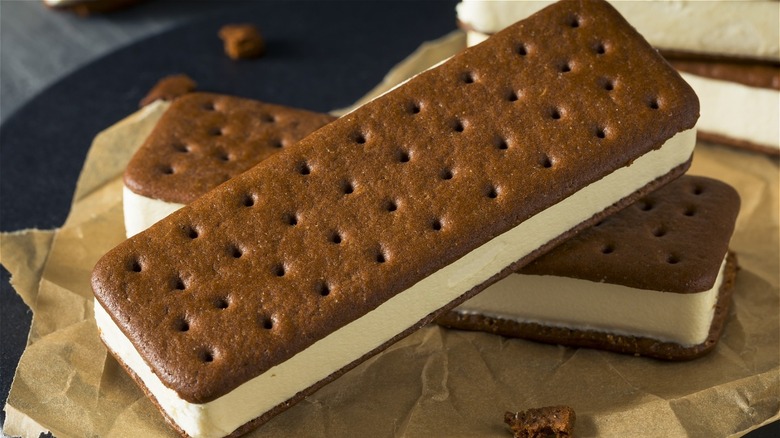The Unexpected Ingredient In An Early Ice Cream Sandwich
Ice cream is a summer staple, but many people enjoy it all year — you may prefer a cone in the summer or a scoop on a slice of warm pie in the fall. Frozen treats have been a hit since ancient times. The International Dairy Foods Association claims King Solomon, Alexander the Great, and Nero Claudius Caesar were fans of sweet icy desserts. People all over the world love it, but the development of the ice cream sandwich seems to be American.
Up until after the invention of the electric refrigerator in the 1930s people relied on ice boxes to store perishable foods, according to the Smithsonian. Keeping a pint of Jeni's or Ben & Jerry's in the freezer simply wasn't an option. Ice cream was a special treat purchased from street vendors or confectioners. One innovative pushcart vendor on the Bowery in New York created the ice cream sandwich in 1899, The New York Times reports.
Despite embracing the trend, customers pushed back on the price tag until the vendor lowered the price to one cent. In 1902, the New York Tribune published, "The sandwich was introduced three years ago, and sold for two years at 2 and 3 cents," until kids demanded the cost be slashed (via The New York Times). Any modern ice cream fan can understand why this innovation caused such a splash, but the biggest surprise is some of the early ice cream sandwich ingredients.
Unexpected ingredients in early ice cream sandwiches
In the late 1800s, vendors wanted an inexpensive way to serve ice cream as street food. People purchased "hokey pokeys," which were small slabs of ice cream placed between pieces of paper, according to the Boston Globe.
That changed with the invention of the ice cream sandwich. In 1899, a Bowery pushcart ice cream vendor in New York sandwiched ice cream between a pair of thin water wafers. The New York Mail reported, "the thin wafers which go to make up the sandwich help to modify the coolness of the ice cream, so that it can be eaten more readily" (per New York Times). The vendor used a tin mold to craft the sandwich by hand for each customer.
However, author and food historian Jeri Quinzio told the Boston Globe that some early ice cream sandwiches used sponge cake as a surprising ingredient. Upscale confectioners started serving ice cream sandwiches made of sponge cake as a more formal dessert compared to the street vendors' offerings.
Today, we are most familiar with ice cream sandwiched between two chocolate cookies. The Daily Herald claims that his version appeared around the 1940s when Jerry Newberg sold them in Pittsburgh. However, Newberg wasn't the first to use cookies: In the 1920s, San Franciscan George Whitney used oatmeal cookies and chocolate to invent It's-Its.

